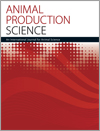
Animal Production Science
Volume 62 Number 4 2022
AN21120Fleece rot and dermatophilosis (lumpy wool) in sheep: opportunities and challenges for new vaccines
Fleece rot and dermatophilosis are sporadic microbial infections of the skin and wool of sheep that decrease the value of wool, predispose animals to fly strike and compromise animal welfare. Recent technical advances create an opportunity to design vaccines to control these diseases. The review describes a path for identifying the key bacterial components for a vaccine and harnessing the genetic potential of sheep to respond to vaccination within an integrated strategy for control of fleece rot and dermatophilosis.
AN21120 Abstract | AN21120 Full Text | AN21120PDF (2 MB) Open Access Article
AN21093Effects of faecal microbiota transplantation on the growth performance, intestinal microbiota, jejunum morphology and immune function of laying-type chicks
 , Yujie Zhou, Qiongyi Wen, Baolin Wang, Haizhou Gong, Lingyu Zhu, Hainan Lan, Bin Wu, Wuying Lang, Xin Zheng and Min Wu
, Yujie Zhou, Qiongyi Wen, Baolin Wang, Haizhou Gong, Lingyu Zhu, Hainan Lan, Bin Wu, Wuying Lang, Xin Zheng and Min Wu
Faecal microbiota transplantation (FMT) is often used to regulate gut microbial colonisation. This study investigated the effects of FMT on the growth performance, intestinal microbiota, jejunum morphology and immune function of newly hatched laying-type chicks. We found that FMT can promote the early growth performance and jejunum morphology of laying-type chicks and improve the intestinal microbiota. FMT may be a potential method to improve the health of chicks to enhance the poultry industry.
AN20523Cassava pulp can be nutritionally improved by yeast and various crude protein levels fed to cattle
So as to compare cassava pulp in two forms, namely, fermented with baker’s yeast or the yeast from LDD 6, under the use of two levels of protein in concentrate mixtures (16% and 18% crude protein, CP), four beef cattle were randomly assigned to treatments according to a 2 × 2 factorial arrangement in a 4 × 4 Latin square design. In conclusion, yeast-fermented cassava pulp with a concentrate of 16% CP resulted in the highest propionate production and a reduction of protozoal population and, hence, methane production in the rumen.
AN20592Effects of methionine as free amino acid and dipeptide on productive efficiency and meat quality of broilers under acute and chronic heat stress
 , Víctor Emanuel Meneses Feitosa, Claudson Oliveira Brito, Leandro Teixeira Barbosa and Eliane Gasparino
, Víctor Emanuel Meneses Feitosa, Claudson Oliveira Brito, Leandro Teixeira Barbosa and Eliane Gasparino
Alternatives to alleviate or combat the harmful effects of heat stress have been constantly studied. Researches have tried to solve these problems by functional nutrients. We investigated the effects of methionine as a free amino acid and as dipeptide for the first time in broilers under acute and chronic heat stress. These studies can be useful to identify viable means of protecting animals and maintaining their productive indices, through nutritional modulation of the animals’ metabolic response to the heat stress.
AN20020Dietary inclusion of purified crude glycerin improves bodyweight at slaughter and affects the fatty acid profile of lamb meat
 , Gleidson Giordano Pinto de Carvalho
, Gleidson Giordano Pinto de Carvalho  , Thadeu Marinello Silva, Jonival Barreto Costa, Vinicius da Silva Oliveira, Lisiane Santos Freitas, Claudio Vaz Di Mambro Ribeiro and Leilson Rocha Bezerra
, Thadeu Marinello Silva, Jonival Barreto Costa, Vinicius da Silva Oliveira, Lisiane Santos Freitas, Claudio Vaz Di Mambro Ribeiro and Leilson Rocha Bezerra 
Crude glycerin is a byproduct of biodiesel production that can be used in the diets of ruminants to replace corn bran, because it has the potential to be a gluconeogenic and, therefore, energetic substrate. Enhancing the diet’s energy density may improve the performance of animals, increasing the carcass fat content and thereby improving the physicochemical composition. Meat parameters, such as colour and shear force, generally represent the appearance, sensory traits and fatty acid profile of lamb meat. Other parameters can predict the meat acceptance by the consumer market.
The increased number of male dairy origin calves in Ireland due to the abolition of European Union milk quotas is a potential resource for the beef industry if they can economically produce meat of acceptable eating quality. Beef from Holstein-Friesian bulls from an under 16-month production system had better quality than beef from a 19-month system and Longissimus thoracis muscle had better quality than Semitendinosus and Gluteus medius muscles. These data assist in the selection of the most effective production system/muscle combination for specific markets.
AN21309Are there opportunities to improve lamb feedlot production efficiency? A cross-sectional survey
A survey of lamb feedlotters investigated current practices in lamb feedlots in Australia, and reported lamb growth rates and feed conversion ratios. The results indicate that the growth rates and feed conversion of lambs in feedlots are what could be expected and any improvements in overall production efficiency would require the identification of feeding strategies capable of increasing nutrient intake, and decreasing the incidence of shy feeders and acidosis.
AN21288Growth of young cattle grazing high-moisture winter forages in a temperate environment was not affected by access to drinking water
 , J. Clariget, A. La Manna
, J. Clariget, A. La Manna  , L. J. Watt, J. T. B. Milton, E. Fernandez, R. Zarza, F. Baldi and D. T. Thomas
, L. J. Watt, J. T. B. Milton, E. Fernandez, R. Zarza, F. Baldi and D. T. Thomas 
In temperate environments, there is often insufficient forage during autumn and early winter to meet the requirements of cattle, but at the same time farmers often have forage available as winter cereal crops. One reason for not grazing such crops is the lack of water points in the cropped paddocks. However, we demonstrate that cattle can perform adequately without access to drinking water when grazing actively growing annual ryegrass or winter cereal crops. This allows the feed gap to be diminished without farmers needing to provide infrastructure for drinking water, that can be costly.



